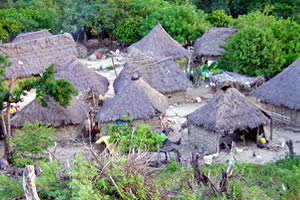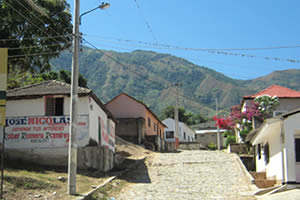The village Ika or Arhuaco (Indigenous reservation)
The village Ika or Arhuaco
They inhabit the upper basins of the rivers Aracataca, Fundación and Ariguaní in the western slope of the Sierra Nevada of Santa Marta, in jurisdiction of the departments of Cesar, La Guajira and Magdalena; Also occupy the areas bordering the lower limit of their shelter, in the Palomino and Don Diego rivers on the north slope and on the south-eastern slope, the upper basins of the Azúcarbuena and Guatapurí rivers.
They share a part of the territory with the Kogui and the Wiwa.
The Arhuacos are a homogeneous group composed of * / - 15,000 people, who live in an area of 195,900 hectares.
The term Arhuaco, as it has been called generally to the ika, was coined by the Spaniards to denominate to the region located in the south slope of the massif, differentiating it of other provinces like Tairona and Chimila.
The history of the indigenous ijka, dates back to the time of the conquest when the Spanish incursion in the territory decimated the so-called Tairona Indians. Once the pacification campaigns of the indigenous provinces that inhabited the territory of La Sierra ended, the precarious situation of Santa Marta during the colonial period allowed the survivors a relative territorial isolation that propitiated their process of ethnic reconstitution. The natives adopted new patterns of subsistence and residence based on their location in areas much more pending than those occupied by Spaniards years ago.
Their pattern of residence is relatively mobile, depending on the possession of two or three "farms" in different places of the shelter. In them they construct round or rectangular houses, covered in straw. The towns in which the population congregates frequently have a male ceremonial house around which the houses are located.
All the towns of the mountain range are considered descendants of the first "parents", for that reason they are the "Big Brothers". The four groups have both patrilineal and matrilineal lineages, that is, the children belong to the paternal lineage and the daughters to the maternal lineage. Nuclear families are established with matrilocal residence (the man resides in the wife's house) and then settled on his own land.
The head of the social structure is represented in the figure of the Mamo. It embodies the social hierarchy of the people.
As for the political organization, the Mamo also heads the structure above the cabildos. They, the Mamos, are the ones who make the decisions and exercise justice. However, in recent years the structure has been changing and the cabildos are becoming more relevant.
At present the Arhuaco are not a homogeneous group, some sectors have developed as a socio-political strategy the roots of their traditions, while others have adopted characteristics of mestizo society such as dress and language. However, different sectors of society continue to participate actively in political decision-making and in other aspects of their culture.
The Ika village practice, as the main economic activity, livestock, specifically cattle and wool. The food diet is complemented by agriculture, which has its main product in the coffee crop.
 The Arhuaca people practice, as main economic activity, livestock, specifically cattle and sheep. The diet is complemented by agriculture, which has its main product in coffee cultivation.
The Arhuaca people practice, as main economic activity, livestock, specifically cattle and sheep. The diet is complemented by agriculture, which has its main product in coffee cultivation.
Despensa de la Sierra wants to share and bring from the sacred ground those products under conditions of optimal quality and hygiene. It is our desire to value and market food of agricultural origin, livestock products craft of the communities of Jewrwa and Morowa in the Arhuaco indigenous reservation of the Sierra Nevada de Santa Marta.
Arango y Sánchez. Los pueblos indígenas de Colombia 1997.
Dane: Censo 1993 -Proyección 2001-
Coronado C., Basilio. Historia Tradición y Lengua Kogui. Editorial Presencia Ltda., Santa Fe de Bogotá, 1993.
Correa, François. Sierras Paralelas, Etnología entre los Kogi y los U‘wa, en: Geografía Humana de Colombia. Tomo IV, Vol., 3, Santa Fe de Bogotá, 1998.
Pérez, María Luisa. Normas del sistema verbal de la lengua kawgian. Tesis de maestría. Posgrado en etnolingüística, Departamento de Antropología, Cela. Universidad de los Andes. Bogotá, 2001.
Fundación Hemera - Etnias de Colombia
Los Pueblos Indígenas de Colombia en el umbral del Nuevo milenio – DNP – Departamento Nacional de Planeación









